Contact:
Lane Smith, Research Program Coordinator, NYSG, E: lane.smith@stonybrook.edu, P: (631) 632-9780
Stony Brook, NY, March 30, 2023 - Here are some summaries for ongoing investigations that address a variety of concerns within a few key topics, including:
(a) Coastal Ecosystems — Improving understanding of eelgrass sediment carbon accumulation rates across the Long Island South Shore and Peconic Estuaries to help assess the potential of these ecosystems aiding in addressing the impacts of ocean acidification
(b) Fisheries and Aquaculture — (1) Examining effective options at shellfish hatcheries to preserve the excess larvae (live), that is currently discarded, so they can be used for later seeding. This will enhance the potential productivity, efficiency, and economic return for the hatcheries, yielding benefit across the industry; (2) Identifying factors limiting recovery of American shad, an important recreational and commercial fishery species in the Hudson River; (3) identifying what communities along New York Harbor and some Long Island coastal waters consider most valuable about oysters, a key cultural and economic species; (4) establishing Gracilariaas, a Red Summer Macroalgae, as a summer seaweed product for NY marine aquaculturists (mainly oyster farmers) in order to diversify what they bring to market; (5) assessing which genetic traits in naturally-occurring scallop populations provide improved survival under heat (due to climate change) and pathogen stress; (6) helping to increase spawning success and assist native fish restoration efforts in Lake Ontario by predicting locations of potentially successful spawning habitats.
(c) Coastal Resiliency — (1) Exploring ways to improve awareness and understanding of rip currents, a leading cause of weather-related fatalities in the U.S., with a focus on enhanced risk communication methods and products to support the Long Island Latinx community.
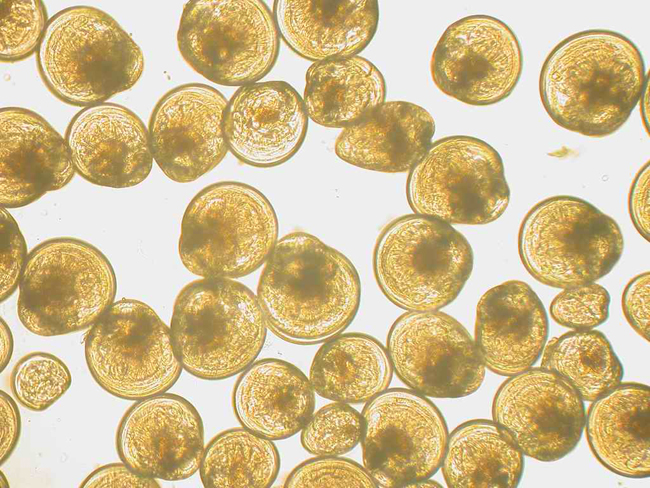
Nine day-old oyster larvae at 100x magnification. These larvae are free swimming for approximately 14 days. They form a transparent shell within 24 hours of fertilization. Credit: Gregg Rivara
Low Temperature Storage of Bivalve Larvae - A New Management Tool for Shellfish Hatcheries (R/ATD-17, Gregg Rivara, Cornell Cooperative Extension)
Shellfish hatcheries provide an essential source of seed stock for the aquaculture industry. Spawning in hatchery operations generally results in many more larvae than can be used at one time. This is due to the high fertility of the species grown and the limited volume of culture vessels available. As a result, shellfish hatcheries discard many more post-spawn larvae than they are able to grow to settling size. This represents a waste of valuable resources that went into producing the broodstock that is discarded. Finding an effective way to preserve the excess larvae (live), that is currently discarded, so they can be used for later seeding will enhance the potential productivity, efficiency, and economic return for the hatcheries, yielding benefit across the industry.
In a research project led by Gregg Rivara at Cornell Cooperative Extension of Suffolk County, the use of cryoprotectants is being explored to keep larvae alive at a very low temperature, with easy-to-use methods, with the aim of extending the useful lives of hatchery larvae. The research team will develop methods that are inexpensive and easy to incorporate into hatchery operations. Storing larvae for periods of weeks to months would allow hatchery operators to reanimate larvae to fill larval culture vessels in response to an incident such as a larval die-off due to a power interruption. Also, such a storage method could conserve the genetic material of an oyster line that shows resistance to a parasite. Low-temperature storage also provides a contingency in the event that it becomes necessary to conduct drastic sanitation to combat disease outbreaks in hatchery facilities.
Enhancing Rip Current Risk Communication in English and Spanish (R/CHD-16, Dr. Jase Bernhardt, Hofstra University)
Rip currents pose a hazard to visitors at Long Island’s, and the nation’s, beaches. They are a leading cause of weather-related fatalities in the United States but are poorly understood by the public. Many groups such as the National Weather Service and local municipalities provide warnings and rip current education to the public. Unfortunately, these rip current risk communication efforts have historically been less effective at reaching bilingual or primarily Spanish-speaking communities in the U.S., putting people at increased risk.
The aim of this project, led by Dr. Jase Bernhardt at Hofstra University, is to improve rip current awareness and understanding, with a focus on enhanced risk communication methods and products to support the Long Island Latinx community. Partnering with local civic organizations, the project team will test existing and newly developed English and Spanish language rip current outreach tools, including a novel virtual reality simulation. The results of this study will provide insights that will be used to develop more effective risk communication tools that can be broadly disseminated across the country.
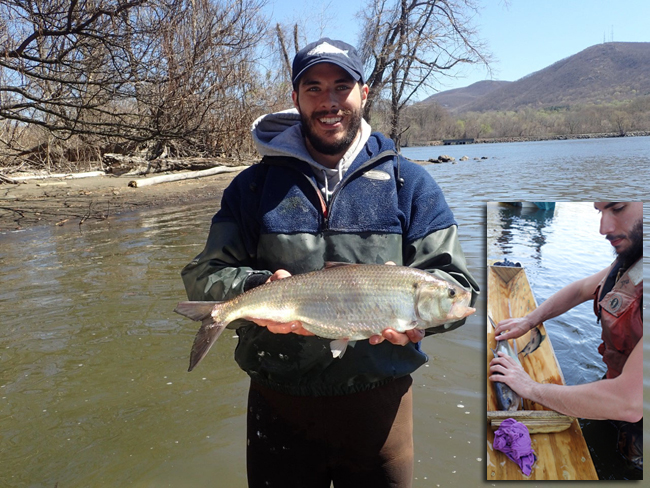
NYSG-supported research on American shad biology and ecology in the Hudson River will aid State and Federal agencies in rebuilding the population. Here, Justin Herne, a fisheries technician in the Hudson River Fisheries Unit of the NYSDEC, holds an American shad taken during annual sampling to monitor the spawning stock and recruitment of the species in the Hudson River Estuary; (Inset) After weighing and measuring the fish, Herne pauses before releasing the fish to the water. Credit: NYSDEC
Evaluating the Changing Biogeography of American Shad in a Changing Hudson River Ecosystem (R/FBF-26, Dr. Yong Chen, Stony Brook University)
The American shad is an important recreational and commercial fishery species in the Hudson River that has become severely depleted. In an effort to help restore the stock, a moratorium on shad fishing was established in 2010. Despite this action, the Hudson River American shad stock has not rebounded. A stock assessment in 2020 found that the adult mortality for the Delaware River American shad stock was unsustainably high and the impacts of this mixed-stock fishery on the Hudson River stock are unknown.
Stony Brook University’s Dr. Yong Chen and his team are using the long-term historical data from the valuable Hudson River Biological Monitoring Program to help identify factors limiting recovery. The research team plan to address how the abundance and distribution of Hudson River American shad changed over time; how long-term environmental changes influence the Hudson River American shad stock dynamics; how might fishing removals from areas outside the Hudson River (e.g., commercial fishery in Delaware Bay and offshore bycatch) affect the Hudson River stock recovery; and how can management effectiveness for the recovery of this important fishery be improved? Results are expected to inform policies and other regulatory measures to help rebuild the population and revitalize this important historic fishery.
Stakeholder Perceptions of Oyster Ecosystem Services: A Mixed Methods Approach to Mapping Services That Improve Management Efficiency (R/FHD-15, Dr. Joshua Drew, SUNY College of Environmental Science and Forestry)
In New York Harbor and Long Island coastal waters, oysters have historically been a key cultural and economic species. Oyster reefs have provided a number of valuable ecosystem services including improved water quality through their filtration activity, habitat, storm surge protection, and of course a source of local seafood. Due to a host of human-induced impacts including degraded water quality, habitat modification, and harvesting, oyster populations have declined to the level where they no longer provide those ecosystem services at a level they once did. Restoration of thriving oyster populations has been a common goal of nearby communities and organizations. However, the different ecosystem services oysters provide are valued differently by different people. These differing priorities can conflict. For example, oysters that are being used to clean up pollutants in an estuary are not suitable for seafood. Because of these multiple and sometimes conflicting services, the management of oysters is not always simple.
A research team led by Dr. Joshua Drew at SUNY College of Environmental Science and Forestry will interview various community members to identify what they consider most valuable about oysters and the ecosystem services they provide. In addition, the team will allow people to clearly identify which services are important to them and provide tools that allow them to understand how those services help shape their daily lives. The project results will help identify areas of commonality and opportunities for collaboration and minimize areas of potential disagreement, for mutually beneficial management and restoration efforts.
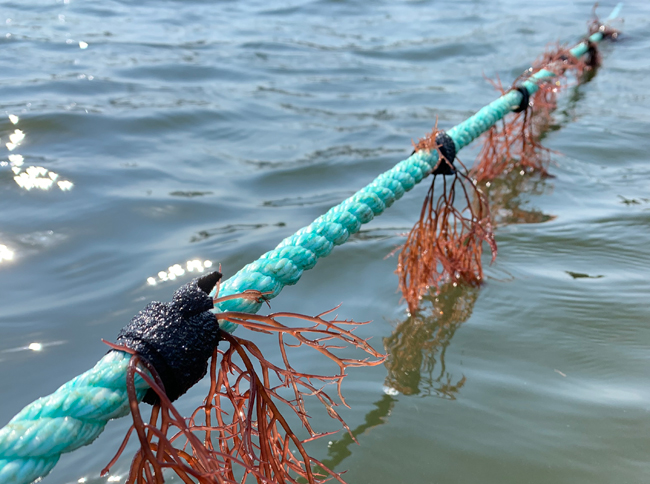
Cultivated Gracilaria hangs from a rope set up in Long Island Sound. Credit: Christopher Gobler
Diversifying New York's Marine Aquaculture Industry: Safely Integrating the Red Summer Macroalgae, Gracilaria, Into Oyster Farms and Other Systems (R/ATD-16, Dr. Christopher Gobler, Stony Brook University)
New York's marine aquaculture industry is primarily comprised of small owner-operated farms focused on one crop - the Eastern oyster, Crassostrea virginica. Despite the great progress and potential for future oyster farm growth, the monocrop nature of the industry leaves it at risk. This was clearly shown during the COVID-19 pandemic when restaurants closed, and the oyster market and industry collapsed. The industry continues to face risk from future disruptions that could have negative economic impacts. To help mitigate that risk, the industry and researchers have looked for ways to build market resilience among oyster farms.
For this project, a research team led by Dr. Christopher Gobler at Stony Brook University seeks to establish Gracilaria tikvahiae as a summer seaweed product for NY marine aquaculturists. Gracilaria is one of the most cultured seaweeds in the world, having commercial value as a food product, source of industrial agar, and fertilizer. Also, previous research by the Gobler lab has shown that Gracilaria is good at absorbing nutrients and improving water quality. The research team seeks to develop and refine multiple, distinct approaches for the successful aquaculture of Gracilaria tikvahiae in NY. The investigators aim to address many of the issues with seaweed aquaculture such as concerns about the general safety of, and contaminant levels within, seaweeds. Also, due to the enhanced use of coastal waters during warmer months, methods for growing Gracilaria tikvahiae in near-shore regions, and on land would be desirable. The research team plans to use the results from the project to assist the industry to improve its market resilience.
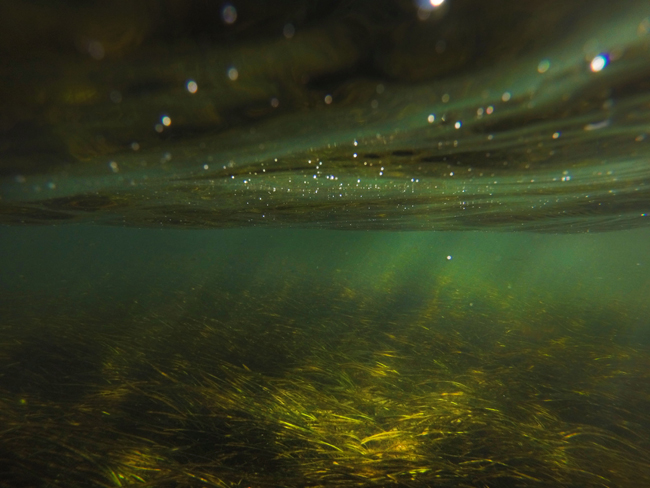
Eelgrass (Zostera marina) can be found in the Long Island South Shore Estuary. The seagrass canopy (made up of the leaves of the plants) soaks up CO2 from the water column as it photosynthesizes. Credit: Kaitlyn O’Toole
Quantifying the Carbon Sequestration Stocks, Sources, and Accumulation Rates of Eelgrass (Zostera marina) in the South Shore and Peconic Estuaries of Long Island (R/CMC-22, Dr. Bradley Peterson, Stony Brook University)
A consequence of increased atmospheric carbon dioxide (CO2) levels has been increased CO2 concentrations in marine waters that cause Ocean Acidification (OA). Ocean Acidification can have adverse impacts on fisheries, especially shellfish. Research has shown that seagrass meadows can be among the most significant blue carbon sinks, capturing CO2 out of the water column. The carbon sequestration by eelgrass (Zostera marina) could be a potential OA mitigation strategy for New York. Although the contribution of seagrass to carbon storage has been acknowledged, most estimates come from just a few sites and seagrass species. Research suggests large variability in seagrass soil carbon stocks is due to a combination of biotic and abiotic factors acting at different spatial scales.
A research team led by Dr. Bradley Peterson at Stony Brook University aims to understand the spatial variability of carbon storage in eelgrass sediments across the Long Island South Shore and Peconic Estuaries. The estimated carbon accumulation rates from the project will help assess the potential of eelgrass ecosystems to help address the impacts of OA in New York.
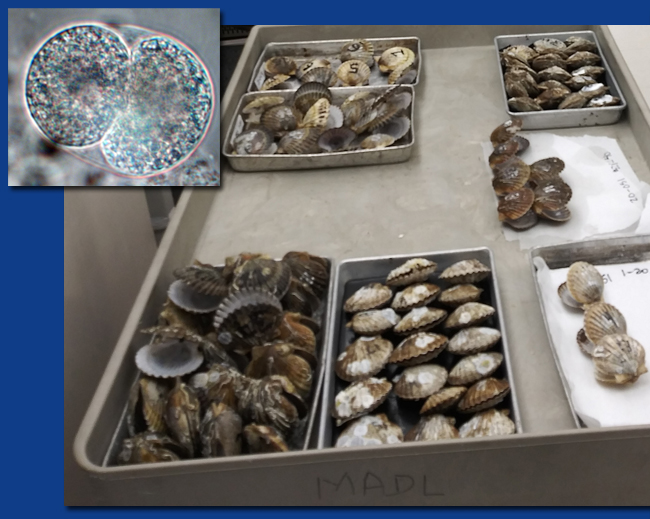
Scallop specimens await examination at SBU’s Marine Animal Disease Laboratory; (Inset) Under a microscope, two parasite cells appear like the number 8. Scientists now designate these parasites ‘bay scallop coccidia’ (BSC). You can just make out the membrane of the scallop cell surrounding the two parasite cells. Credit: Bassem Allam
Against All Odds: Development of Bay Scallop Strains That Resist Temperature and Disease Stress (R/XG-34, Dr. Bassem Allam, Stony Brook University)
The bay scallop fishery on Long Island faces challenges from both pathogens and climate change. This was made evident after large adult scallop die-offs in the Peconic Estuary in 2019 and 2020 negatively impacted the industry. Evidence suggests that the cause of the mortalities is a combination of temperature stress and infection by an apicomplexan parasite dubbed bay scallop coccidia (BSC).
An NYSG-funded team led by Dr. Bassem Allam at Stony Brook University will assess which genetic traits in naturally-occurring scallop populations provide improved survival under heat and pathogen stress. The investigators will evaluate whether a better resistance to temperature stress (both in juveniles and adults) protects scallops from severe BSC infections. The results will identify genotypes of resistant scallops that can facilitate the recovery of bay scallops in New York waters through the future development of selective breeding programs that support the bay scallop fishing industry. It is expected that the results will facilitate the recovery of bay scallops in NY waters and will serve as a reference for establishing selective breeding programs across the region.
Using Coupled Hydrodynamic and Coastline Erosion Modeling to Predict the Impact of Physical Drivers Influencing Native Fish Egg Incubation Success in Lake Ontario (R/CCP-21, Dr. Joseph Atkinson, University at Buffalo)
Increased sedimentation in shallow lake waters is likely having a negative effect on native fish egg survival in Lake Ontario by degrading spawning habitat. Native shallow water species like Cisco, Lake Whitefish, Lake Trout, and Burbot share a common spawning strategy, depositing eggs in late fall over relatively shallow substrates with low siltation rates, where the spaces between sand grains protect the nutrient-rich eggs from predators and physical disturbance during their four- to five-month incubation. The degradation of this spawning habitat has added to a host of other anthropogenic changes that have acted in concert to reduce these native fish populations.
University at Buffalo’s Dr. Joseph Atkinson and his team aim to characterize sedimentation conditions of selected spawning areas affected by human-induced alterations that include morphological and sedimentation changes, and climate change that modifies ice cover, and to use this knowledge to develop guidance for alterations (e.g., artificial reefs, reef cleaning) that can improve spawning success. Results are expected to help inform effective mitigation strategies that can increase spawning success and assist native fish restoration efforts by predicting locations of potentially successful spawning habitats.
More Info: New York Sea Grant
New York Sea Grant (NYSG), a cooperative program of Cornell University
and the State University of New York (SUNY), is one of 34 university-based
programs under the National Oceanic and Atmospheric Administration’s
National Sea Grant College Program.
Since 1971, NYSG has represented a statewide network of integrated
research, education and extension services promoting coastal community
economic vitality, environmental sustainability and citizen awareness
and understanding about the State’s marine and Great Lakes resources.
Through NYSG’s efforts, the combined talents of university scientists
and extension specialists help develop and transfer science-based
information to many coastal user groups—businesses and industries,
federal, state and local government decision-makers and agency managers,
educators, the media and the interested public.
The program maintains Great Lakes offices at Cornell University, SUNY
Buffalo, SUNY Oswego and the Wayne County Cooperative Extension office
in Newark. In the State's marine waters, NYSG has offices at Stony Brook
University in Long Island, Brooklyn College and Cornell Cooperative
Extension in NYC and Kingston in the Hudson Valley.
For updates on Sea Grant activities: www.nyseagrant.org has RSS, Facebook, Twitter, Instagram, and YouTube links. NYSG offers a free e-list sign up via www.nyseagrant.org/nycoastlines for its flagship publication, NY Coastlines/Currents, which is published quarterly.